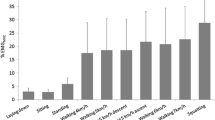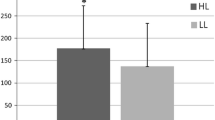Abstract
The purpose of the present study was to investigate the influence of submaximal training of increasing intensity on the rate of fatigue and on the anthropometry of the quadriceps muscle. A group of 24 middle-aged male subjects trained three times a week for 12 weeks at incremental exercise intensities which elicited 66%–83% of the maximal heart rate reserve; 11 male subjects acted as controls. A purpose-built, isometric chair with an adjustable force transducer ensured a standard posture for each subject during a 20 s maximal voluntary contraction (MVC). The muscle plus bone mass of the thigh was calculated from a previously validated anthropometric method reinforced by measurements derived from water displacement and ultrasonics. Training-induced submaximal relationships were assessed by means of two ergometer tests of progressive intensity. Following training, the subjects' blood lactate concentrations had decreased from 5.5 (SD 1.7) to 3.9 (SD 1.4) mmol·1−1 (P < 0.01) at the final exercise intensities. They increased thigh volumes from 10.7 (SD 1.7) to 11.0 (SD 1.7) 1 (P < 0.05) and thigh forces in 47.5% (P < 0.05) of the measurements. Heart rates and rates of perceived exertion were reduced (P < 0.01) following training; for the controls, all the above parameters remained constant. These results would seem to indicate that a submaximal type of training could enable a group of middle-aged men to increase the isometric forces of the thigh muscles by almost 50% when completing a MVC test following training. This suggests that this is a more suitable, safer form of maintaining and increasing maximal thigh forces for this, and older, age groups than specific isometric training alone.
Similar content being viewed by others
References
Alexander R, Vernon A (1975) The dimensions of the knee and ankle muscles and the forces they exert. J Hum Mov Stud 1:115–123
Astrand I (1960) Aerobic work capacity in men and women with special reference to age. Acta Physiol Scand 49 [Suppl 169]:46–48
Astrand P-O, Rodahl K (1986) Textbook of work physiology. McGraw Hill, New York
Borg GAV (1985) An introduction to Borg's RPE scale. Movement Publications, Ithaca, New York
Borkan G, Hults D, Cardarelli J, Burrows B (1982) Comparison of ultrasound and skinfold measurements of subcutaneous and total fatness. Am J Phys Anthropol 58:307–313
Burke E, Irvine E, White J (1990) Physiology of sports. Reilly T, Secher N, Snell P, Williams C (eds) Spon, London, p 173
Burke R, Levine D, Zajac F, Tsairis P, Engel W (1971) Mammalian motor units: physiological-histological correlation in three types in cat gastrocnemius. Science 174:709–712
Cooper KH (1981) The new aerobics. Bantam Books, pp 29–30
Davies CTM, McDonough M (1982) Central and peripheral mechanisms of muscle fatigue. In: Davies B, Thomas G (eds) Clarendon Press, Oxford, p 23
Edstrom L, Larsson L (1987) Effects of age on contractile and enzyme-histochemical properties of fast- and slow-twitch single motor units in the rat. J Physiol 392:129–145
Edwards R (1981) Human muscle function and fatigue. In: Porter R, Whelan J (eds) Human muscle fatigue: physiological mechanisms. Ciba Foundation Symposium 82. Pitman Medical, London
Goldberg A, Etlinger J, Goldspink D, Jablecki C (1975) Mechanism of work-induced hypertrophy of skeletal muscle. Med Sci Sport Exerc 7:248–261
Gollnick P, Armstrong R, Saltin B, Saubert C, Sembrowich W, Shephard R (1973) Effect of training on enzyme activity and fibre composition of human skeletal muscle. J Appl Physiol 34:107–111
Hagberg J (1986) Central and peripheral adaptations to training in patients with coronary artery disease. In: Saltin B (ed) Biochemistry of exercise VI. International Series on Sports Science 16 Human Kinetics, Champaign, Ill., p 268
Hollander A, Boumann L (1975) Cardiac acceleration in man elicited by a muscle-heart reflex. J Appl Physiol 38:272–278
Herber F, Scheidegger J, Grunig B, Frey F (1985) Thigh muscle mass and function in patients treated with glucocorticoids. Eur J Clin Invest 15:302–307
Hultman E, Sjoholm H, Sahlin K, Edstrom L (1981) Glycolytic and oxidative energy metabolism and contraction characteristics of intact human muscle. In: Human muscle fatigue: physiological mechanisms. Ciba Foundation Symposium. 82 Pitman Medical, London, p 19
Ikai M, Fukanaga T (1970) A study of the training effect on strength per unit cross-sectional area of muscle by means of ultrasonic measurement. Int Z Ang Physiol Einsch Arbeit 28:173–180
Ingjer F (1979) Effects of endurance training on muscle fibre ATPase activity, capillary supply and mitochondrial content in man. J Physiol (Lond) 294:419–432
Jones D, Rutherford O (1987) Human muscle strength training: the effects of three different regimes and the nature of the resultant changes. J Physiol (Lond) 391:1–11
Jones PRM (1970) An application of physiological anthropometry. Thesis, Loughborough University, England
Jones PRM, Pearson J (1969) Anthropometric determination of leg fat and muscle plus bone volumes in young male and female adults. Proc Physiol Soc (July) 63P–66P
Jones PRM, Davies P, Norgan N (1986) Ultrasonic measurements of subcutaneous adipose tissue thickness in man. Am J Anthropol 71:359–363
Karvonen M, Kantala E, Mustala D (1957) The effects of training on heart rate. Ann Med Exp Fenn 35:307–315
Keul J (1973) Muscle metabolism during long lasting exercise. In: Howald H, Poortmans J (eds) Metabolic adaptation to prolonged physical exercise. Proceedings of 2nd International Symposium on the Biochemistry of Exercise. Birkhäuser Verlag, Basel
Klausen K (1990) Strength and weight-training. In: Reilly T (ed) Physiology of sports. Spon, London, p 41
Komi P (1986) How important is neural drive for strength and power development in human skeletal muscle? In: Saltin B (ed) International Series on Sports Science, vol 16. Biochemistry of exercise VI. Human Kinetics, Champaign, Ill.
Lindh M (1979) Increase in muscle strength from isometric quadriceps exercise at different knee angles. Scand J Rehabil Med 11:33–36
Maughan R (1982) A simple, rapid method for the determination of glucose, lactate, pyruvate, alanine, 3-hydroxybutyrate and acetoacetate on a single 20 mocrolitre blood sample. Clin Chim Acta 122:231–240
Pacy P, Webster J, Garrow J (1986) Exercise and obesity. Sports Med 3:89–113
Ramsbottam R, Nute M, Williams C (1987) Determinants of five kilometre running performance in active men and women. Br J Sports Med 21:9–13
Renstrom P (1981) The below-knee amputee. Thigh muscle atrophy in below-knee amputees. Thesis, University of Goteborg, Sweden, pp 72–83
Saltin B, Nazar K, Costill D, Stein E, Jansson E, Essen B, Gollnick P (1976) The nature of the training response. Peripheral and central adaptations to one-legged exercise. Acta Physiol Scand 96:289–305
Tanner J, Whitehouse R (1957) The Harpenden anthropometer, a counter type anthropometric caliper. Am J Phys Anthropom 15:277–280
Thompson C (1985) Manual of structural kinesiology, 10th edn. Times Mirror, St. Louis
Wilmore J, Davies J, O'Brien R, Vodak P, Walder G, Amsterdam E (1980) Physiological alterations consequent to 20-week conditioning programs of bicycling, tennis and jogging. Med Sci Sports Exerc 12:1–8
Young A, Stokes M, Round J, Edwards R (1983) The effect of high resistance training on the strength and cross-sectional area of the human quadriceps. Eur J Appl Physiol 13:411–417
Author information
Authors and Affiliations
Rights and permissions
About this article
Cite this article
Williams, D.H., Lakomy, H.K.A. & Williams, C. Anthropometric determination of thigh volumes and thigh forces following acute training of increasing intensity in adult men. Eur J Appl Physiol 72, 528–536 (1996). https://doi.org/10.1007/BF00242286
Accepted:
Issue Date:
DOI: https://doi.org/10.1007/BF00242286




